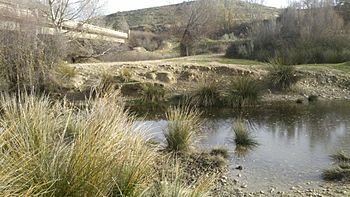Torote facts for kids
Quick facts for kids Torote |
|
|---|---|

Rio Torote close to N-320 bridge
|
|
| Country | Spain |
| Physical characteristics | |
| Main source | Cerro Picorroble 956 m (3,136 ft) |
| River mouth | Henares 687 m (2,254 ft) |
| Length | 43.85 km (27.25 mi) |
| Basin features | |
| Progression | Henares→ Jarama→ Tagus→ Atlantic Ocean |
The Torote is a river in Spain. It is a tributary of the Henares river. This means the Torote flows into the Henares. The Torote starts near a hill called Picorroble. This hill is in the province of Guadalajara.
Contents
The Torote River: A Journey Through Spain
The Torote river is an important part of the landscape in central Spain. It flows for about 43.85 kilometers (about 27 miles). This makes it a medium-sized river. It starts high up in the mountains and flows downhill.
Where the Torote Begins
The journey of the Torote river begins at Cerro Picorroble. This is a hill located in the province of Guadalajara. The word "Cerro" means hill in Spanish. The river's source is about 956 meters (3,136 feet) above sea level. This high starting point gives the river its energy to flow.
The River's Path
From its source, the Torote river flows through different areas. It travels through parts of the Guadalajara province. It also passes through the Community of Madrid. As it flows, the river collects water from smaller streams. These streams join the Torote on its way.
From Hill to Henares
The Torote river continues its journey until it reaches the Henares river. The place where one river flows into another is called its "mouth." The Torote's mouth is about 687 meters (2,254 feet) above sea level. This shows how much the river drops in elevation from its source. The Henares river is a larger river. It is part of the Tagus river basin.
Why Rivers Are Important
Rivers like the Torote are very important for many reasons. They provide water for plants and animals. They also help shape the land around them. Rivers create homes for fish and other wildlife. They can also be used for fun activities like fishing or walking along their banks.
See also
 In Spanish: Río Torote para niños
In Spanish: Río Torote para niños

